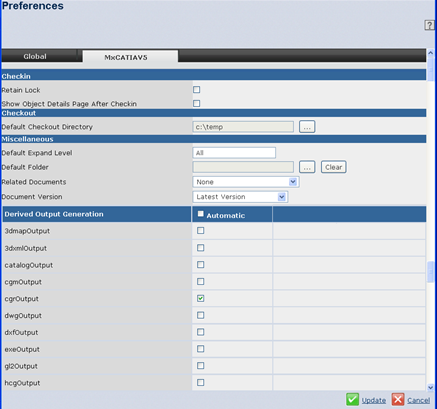Click ENOVIA V6 > Preferences in the CATIA V5 application.
The Preferences page opens in your browser.
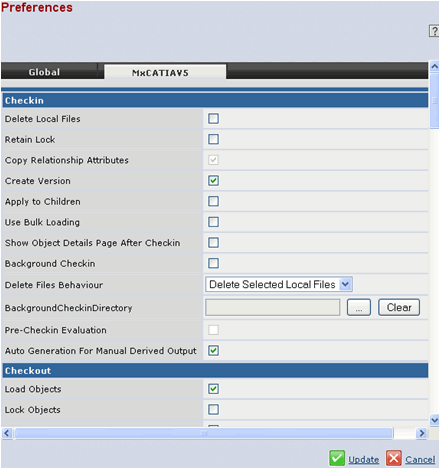
The Preferences page has the following tabs:
- Global
- MxCATIA V5
Click the CATIA V5 tab to set the preferences for the following
ENOVIA functions:
Checkin
Checkout
Miscellaneous
Derived Output Generation
Default Type Policy Settings
Selected Default Tables
Under Checkin section in the Preferences page, you can set the following:
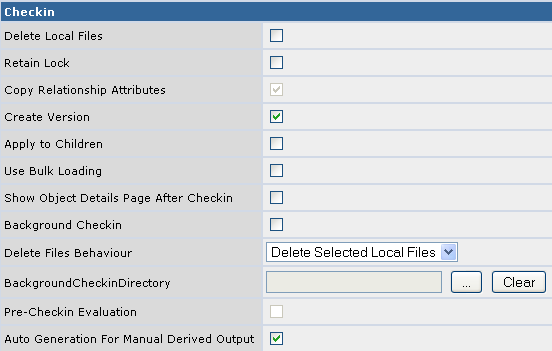
Delete local files--Select this option to select the Delete Local Files
option in the Checkin page by default
Retain Lock--Select this option to select the Retain Lock option in
the Checkin page by default.
Copy Relationship Attributes--This option is
used to copy the relationship attributes upon checkin by default. This
option is always selected and cannot be edited.
Create version--Select this option to select the Create Version option
in the Checkin page by default.
Apply to Children--Select this option to select the Apply to Children
option in the Checkin page by default
Use Bulk Loading--Select this option to use bulk loading for checkin
by default.
Files that are checked in using bulk loading are not displayed in
the Recently Checked In Files tab in the Powerview page.
Show Object Details Page After Checkin--Select this option to open
the object details page of the object that is checked in.
Background Checkin --Select this option to select the Background Checkin
option in the Checkin page by default.
Delete Files Behaviour--Select DeleteSelectedLocalFiles or DeleteAllFiles
from the drop down.
- Select DeleteSelectedLocalFiles to delete only the
files that are selected in the Checkin page.
- Select DeleteAllFiles to
delete the files that are selected in the Checkin page as well as the
files with EXISTS and EXIST_TypeChange.
BackgroundCheckinDirectory--Click  and select a directory in your machine where you want to store the objects
upon background checkin.
and select a directory in your machine where you want to store the objects
upon background checkin.
Pre-Checkin Evaluation--This field is not currently
used.
AutoGenerationForManualDerivedOutput--Select this option to enable
auto generation of manual derived output option in the Derived Output
page.
Under the Checkout section in the Preferences page, set the following:
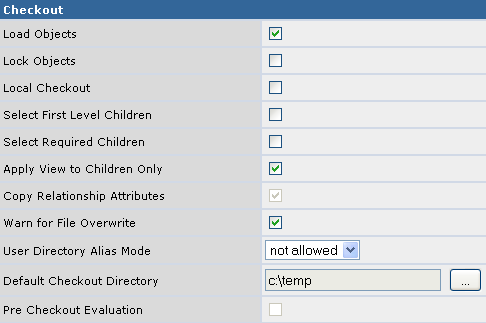
Load Objects--Select this option to select the Load Objects option by
default in the Checkout page.
Lock Objects--Select this option to select the objects in the Checkout
page for lock by default.
Select First Level Children--Select this option to select the Select
First Level Children option by default in the Checkout page.
Copy Relationship Attributes. This option is
used to copy the relationship attributes upon check out by default. This
option is always selected and cannot be edited.
Warn for File Overwrite--Select this option to enable a warning page
before any existing files are overwritten due to checkout.
Related View registry--You can select your choice of related views
registry here. Views in the particular view registry appear here.
User Directory Alias Mode--Select the user directory alias mode to
allow the DL Names or aliases for the directory from the options:
- not allowed--the DLNames are not allowed and displayed.
- allowed--the DLNames and the other directories are displayed when
you browse to select a location for checkout.
- current--only the DLNames are displayed when you browse to select
a location for checkout.
Default Checkout Directory --Set your default checkout directory in the
Checkout page. A valid location must be specified as the default
checkout directory for Assign Part on Checkin feature to function. See
About Check In for more details.
Note:
The Default Checkout Directory path in the Preferences page is always
displayed in small case. For example, the path is displayed as d:/enovia,
even if the actual path is D:/ENOVIA.
Under the Miscellaneous section, set the following preferences:
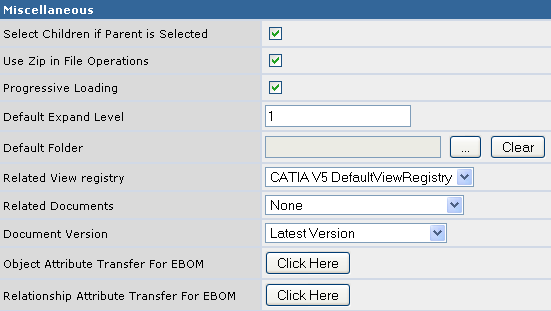
Select Children if parent is selected--Select this option to select
the child components by default when a parent node is selected.
Use Zip in File Operations--Select this option to enable zip compression
for file transactions in ENOVIA.
Progressive Loading--Select this option to bring the structure information
while selecting checkout from the object or upon expanding the structure
in the Checkout or the Promote page
Default Expand Level--Set the default number of levels of expansion
of a CATIA V5 structure when displayed.
The Derived Output section on the Preferences page lists all the Derived
Output types, listed in the Integration Global Config Object, with checkboxes.
Select the Derived Output types by selecting the check boxes from the
list.
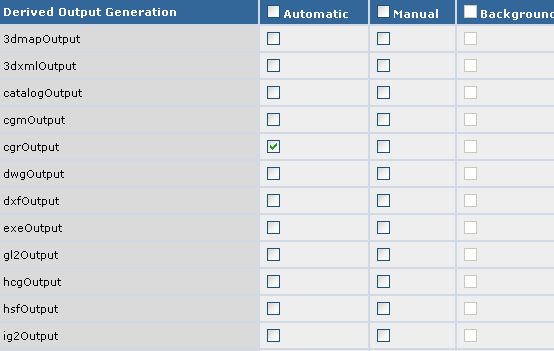
Automatic. Select the checkbox for the file formats
to automatically generate the derived outputs on check in.
Manual. Select the checkbox to generate the
Manual Derived Output for the selected formats.
Background. Select the checkbox to generate
the derived outputs in background. Using this option, the derived output
is not generated during checkin. All the selected derived outputs are
created and checked in in silent mode. By default, the Background option
is disabled. Administrators can enable this option while configuring
Background Derived Output Processor.
The following file formats are supported:
- image_jpg
- postscript
- cgrOutput
- igesOutput
- stepOutput
- pngOutput
- exeOutput
- hsfOutput
- txtOutput
- wrlOutput
- stbomOutput
- 3dxmlOutput
- stlOutput
- modelOutput
- 3dmapOutput
- hcgOutput
- vpsOutput
- dxfOutput
- dwgOutput
- cgmOutput
- svgOutput
- gl2Output
- catalogOutput
- pdfOutput
- tifOutput
- ig2Output
The selected types from this list are shown pre-selected during check in.
Default Type Policy Settings section is used to select the policies for Default Design Policy and Default
Versioned Design Policy for CATIA V5 types. The policies CATIA V5 Design
Policy and Versioned CATIA V5 Design Policy specific to ENOVIA Collaborative
Design for CATIA V5 are selected by default as the default policies.
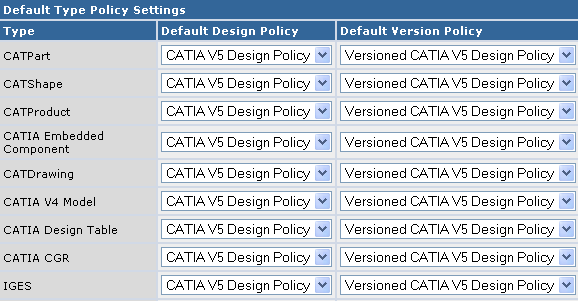
You can set a different policy as default using the drop down list. Though the Preferences page allows selection of Design Policy
as Default Design Policy and Versioned CATIA V5 Design Policy as Default
Version Policy, or CATIA V5 Design Policy as Default Design Policy and
Versioned Design Policy as Default Version Policy, it is recommended
to use Design Policy and Versioned Design Policy together and CATIA V5
Design Policy and Versioned CATIA V5 Design Policy together
CATIA V5 Design Policy and Versioned CATIA V5 Design Policy policies
support all the existing CATIA V5 Integration features. The Integration
Administrator can customize these policies as per business requirements
The administrator can enforce a default policy for a particular Type.
You can set the default table to be applied to the list of Designer
Central pages on the Preferences page. Select the default table you want
to apply to the appropriate pages in Designer Central from the drop-down
list of workspace tables displayed.
Click Update to save and update the preferences.

